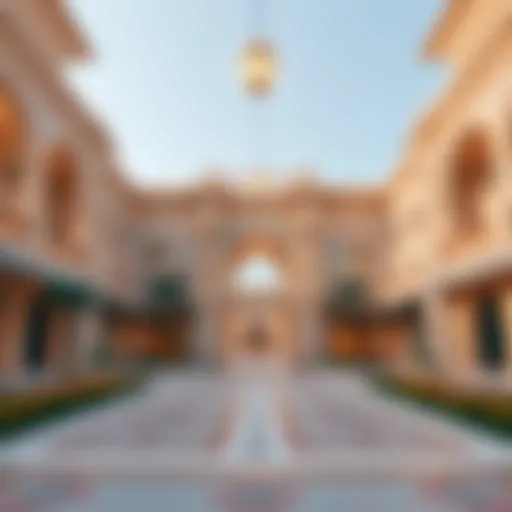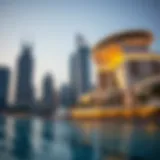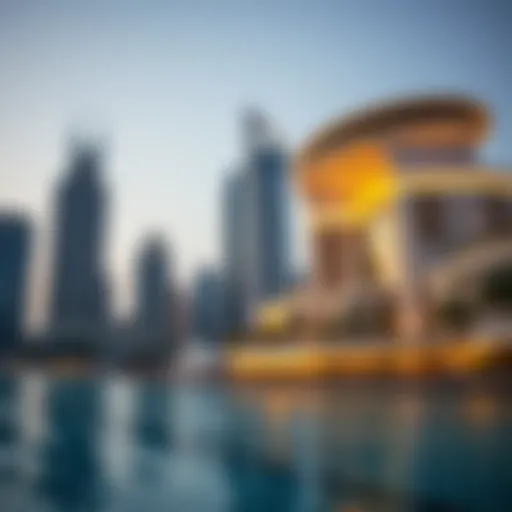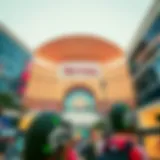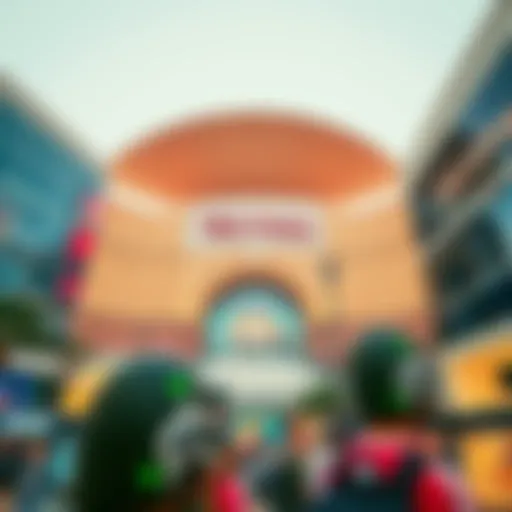Explore the Dubai Metro System: Your Ultimate Guide


Intro
Dubai, a city bursting with life and opportunity, has transformed itself into a global hub for business and tourism. One often-overlooked aspect of this ever-evolving metropolis is its metro system. The Dubai Metro, with its sleek design and efficient services, is more than just a means to traverse the urban landscape; it is a critical component of Dubai's infrastructure that reshapes the way people live, work, and invest in the city. Understanding this system and its connectivity is vital for anyone looking to navigate Dubai, whether for daily commutes, exploration, or even investment.
With two main lines—the Red Line and the Green Line—the metro connects a multitude of key areas ranging from bustling commercial districts to serene residential neighborhoods. Each station stands as a gateway to essential destinations like the Dubai Mall, Dubai Marina, and major business hubs. The connectivity provided by this metro system greatly influences the dynamics of real estate, making it a topic worth delving into.
In this comprehensive guide, we will break down the intricacies of the metro map, provide insights into market trends, highlight investment opportunities, and suggest tips for ease of navigation. This information will be invaluable for investors, homebuyers, real estate agents, and analysts alike, seeking a holistic view of how proximity to the metro can enhance property values.
Embracing the metro is more than a choice; it's part of the lifestyle in Dubai, connecting lives and opportunities in a seamless manner. As we explore further, keep in mind the impact of the metro on the city and its real estate climate, because understanding these factors could very well be the key to making informed decisions in this vibrant market.
Prelims to Dubai Metro
The Dubai Metro system is not merely a means of transportation; it represents a monumental leap in urban mobility within one of the world's most dynamic cities. With a blend of speed, efficiency, and modern technology, the metro network serves as the lifeblood for countless commuters and tourists alike. Understanding the intricacies of this network is essential for investors, homebuyers, and anyone looking to engage with Dubai's vibrancy. It’s crucial to take note of how the metro enhances connectivity, aligning an array of public and private developments, thereby reshaping the real estate landscape.
Historical Background
Delving into the historical background reveals why the metro is integral to Dubai's evolution. Initiated in 2005, the Dubai Metro was a visionary answer to the congestion challenges that threatened the city's drive towards modernization. The first line, the Red Line, officially opened in September 2009. It was a trailblazing effort, designed to alleviate traffic and enhance the quality of urban life.
Back then, many were skeptical about the feasibility and sustainability of such a project. However, the prevailing narrative changed when the metro quickly became a preferred choice for both residents and tourists. In fact, a report from the Roads and Transport Authority highlighted that by 2010, the metro was already achieving a ridership of about 8 million passengers a month.
Thus, the establishment of the Dubai Metro marked a significant turning point, not just in public transport but in the broader context of urban planning in the region. It paved the way for an integrated transport system that would later include trams and buses.
Evolution and Expansion
As we transition into discussing the evolution and expansion of this network, it's vital to emphasize the continued growth that has defined the metro since its inception. After the successful launch of the Red Line, the Green Line followed in 2011, adding further connectivity across the downtown and older districts of Dubai. Notably, expansion did not stop there. New lines and extensions have been rolling out with remarkable rapidity.
The addition of the Route 2020 was particularly noteworthy, aimed at connecting the metro with the Expo 2020 site, symbolizing Dubai’s aspirations and its commitment to remaining at the forefront of global innovation. These expansions illustrate not just a response to immediate urban demands, but a vision for a sustainable and accessible future.
For potential investors, it becomes vital to recognize the correlation between metro accessibility and property values. Areas serviced by metro lines have shown more robust performance in terms of real estate dynamics. It becomes apparent that with each phase of expansion, the potential for increased footfall and value appreciation intensifies.
Map Overview
The Dubai Metro serves as the arteries of the city, facilitating not just the movement of residents but also the influx of tourists and business opportunities. Understanding the metro map is crucial for anyone traversing this bustling metropolis, as it connects vital areas, compressing urban sprawl into a convenient transit experience. Navigating through Dubai's roads can feel daunting, but the metro offers an organized route that eliminates the unpredictability of traffic jams and parking woes.
A well-designed metro map not only showcases the physical layout of the lines and stations, but it also underscores the strategic choices made in urban planning, enhancing accessibility and economic growth. For investors and homebuyers, understanding the layout of the system helps gauge which neighborhoods are thriving and which ones may be on the up-and-up.
Key considerations include:
- Ease of Access: Lines are designed to make it easier for commuters to switch between metros and other forms of transport without significant delays.
- Coverage: The metro connects key areas such as the Dubai Marina, Downtown Dubai, and the Expo 2020 site, linking business districts with residential zones.
- Significance for Development: Areas near metro stations often experience higher property demand due to their improved connectivity, making them attractive for real estate investments.
Description of Major Lines
The Dubai Metro has two main lines: the Red Line and the Green Line. Each line is a marvel in its own right, stretching across diverse landscapes and connecting various districts.
- Red Line: The Red Line is the backbone of the metro network. It runs from Al Rashidiya in the east to UAE Exchange in the west, covering 52 kilometers. Key stops along this line include:
- Green Line: The Green Line runs from Etisalat and traverses through one of the city’s oldest districts, Al Quoz. Spanning 23 kilometers, this line directly links several important neighborhoods, including:
- Burj Khalifa/Dubai Mall: What more can one ask than a direct line to the world’s tallest building and one of the largest shopping malls?
- Dubai Marina: This picturesque area is a hotspot for both tourists and residents, vibrant with a mix of leisure activities.
- Dubai International Airport (Terminal 1 and 3): An invaluable connection for international travelers.
- Al Rigga: A bustling area that boasts a nightlife scene and a variety of restaurants.
- Deira: This historic part of Dubai is rich with culture and is a must-visit for many tourists.
- Dubai Healthcare City: Central to healthcare services, showcasing the emirate's commitment to health innovation.
Overall, the lines represent a fusion of modern engineering and the cultural tapestry that is Dubai. They embody a commitment to sustainability while pushing the city towards a more interconnected future.
Key Stations and Interchanges
Diving deeper into key stations and interchanges sheds light on the Dubai Metro’s efficiency and user-friendly design. Consider this: the interconnections between various transport modes can save both time and money.


- Burj Khalifa/Dubai Mall Station: This station not only serves the iconic landmark but also acts as a hub for both tourists and business professionals. The station's proximity to the mall makes it convenient for those wishing to indulge in shopping while enjoying stunning views.
- Union Station: This pivotal interchange connects the Red and Green lines, allowing for seamless transfers. For commuters, this means less hassle and more convenience, especially during peak hours.
- Al Ghubaiba Station: Serving buses at one end, the Al Ghubaiba station is a critical interlink for residents heading toward southern Dubai or Ajman. The ease of switching from metro to bus without long wait times is a game changer.
- Emirates Towers Station: Nestled in the heart of the business district, this station underscores the importance of the metro as a vital transport link for professionals and travelers alike.
Each station exhibits unique architectural designs and practical amenities, boosting overall user satisfaction and encouraging greater public transport adoption.
In essence, understanding the Dubai Metro’s map structure and its major lines helps paint a picture of not just a transportation network, but also a future-focused city paving its way towards sustainability and urban integration.
Operational Features
Understanding the operational features of the Dubai Metro system provides insight into its effectiveness as a public transport solution and its vital role in the city’s infrastructure. The operational elements are crucial not just for daily commuters but also hold significance for potential investors and homebuyers considering properties near the metro stations. The reliability, frequency, and user experience directly impact the desirability of areas around the metro, making a strong case for the importance of this section.
Frequency and Timings
Dubai Metro prides itself on its punctuality and efficiency. With services running frequently throughout the day, passengers can rely on the system, thus reducing waiting times significantly. Most metro lines operate at intervals of approximately 6–8 minutes during peak hours, while the wait may extend to about 10–15 minutes during off-peak times. This aspect appeals not only to daily commuters but also to tourists who require a dependable mode of transport.
The operational hours extend from 5 AM to midnight on weekdays, with extended hours during weekends and public holidays, offering flexibility for late-night events or early-morning travels. This convenience is a substantial advantage for those investing in properties close to metro stations, as it enhances the lifestyle appeal of the area.
Additionally, for local businesses, the increased flow of people using the metro during operational hours can boost foot traffic, creating vibrant atmospheres in neighborhoods.
One of the key features of the Dubai Metro is its advanced scheduling system, which adjusts based on real-time demand. Such innovations ensure that service remains smooth and adequately fulfills passenger needs.
"A well-timed metro can make all the difference for daily commuters, enhancing their overall travel experience and boosting local economies."
Ticketing and Fares
Navigating the ticketing system of the Dubai Metro is straightforward, making it user-friendly for both locals and visitors. Fares are calculated based on the distance traveled, with various pricing tiers that accommodate different travel needs. This flexibility caters to diverse demographics, from tourists looking to explore the city to frustrated daily commuters seeking cost-efficient travel solutions.
The payment system is primarily electronic, utilizing the Nol card, which can be easily topped up at various machines and terminals throughout the metro stations. This electronic system enables seamless travel without the need for cash transactions, saving time and reducing queuing at ticket counters.
Certain discounts apply for specific groups, such as students and senior citizens, further enriching the accessibility of the metro. Investors and homebuyers should consider the affordability of commuting options when assessing property value since access to such cost-effective transport can significantly affect decisions on where to live or invest.
Overall, a well-structured ticketing approach not only enhances user experience but also attracts a diverse range of individuals to the service, positively influencing the urban landscape around metro stations.
Connecting the City
The Dubai Metro system serves as a vital thread in the fabric of the city’s transportation network. Its ability to seamlessly link different modes of transit plays a significant role in easing congestion, providing convenience, and enhancing accessibility throughout the metropolis. In this section, we delve into how the metro connects with buses and trams, as well as its access to key landmarks and areas, making it an essential resource for residents and visitors alike.
Integration with Buses and Trams
The integration of the Dubai Metro with its bus and tram services is nothing short of remarkable. This well-orchestrated synergy not only enhances the overall commuting experience but also fuels the metro's popularity among the masses. With numerous bus connections at various metro stations, commuters can easily transfer between routes, ensuring that even the furthest reaches of Dubai are within easy reach.
A look at the Dubai Public Transport system reveals the following advantages:
- Seamless Transfers: Passengers can switch from the metro to bus services without the hassle of long waits. This workflow minimizes the total travel time on any given journey.
- Expanded Coverage: The bus network complements the metro lines, covering areas that are not directly accessible by train. With bus stops strategically located near many metro stations, users benefit from a truly interconnected transport system.
- Tram Networks: The brand new Dubai Tram service runs parallel to parts of the metro, extending access to pivotal areas such as Dubai Marina and Jumeirah Beach Residence (JBR). This synergy enriches the city's social and commercial vibrancy.
"The seamless integration between buses, trams, and the metro has revolutionized public transport in Dubai, turning what was once a city of cars into a model of modern urban mobility."
The implementation of certain technological solutions, such as smart card systems, further assists commuters. One card can be used across various transport modes, facilitating a smooth ride, and rooting out the confusion often associated with multiple transport systems.
Access to Key Landmarks and Areas
As one of the most ambitious public transport projects in the region, the Dubai Metro stands out not just for its efficiency but for the prime access it provides to numerous landmarks across the skyline. Each station is strategically located to maximize convenience for both residents and tourists, guiding them to experience the best Dubai has to offer.
Key landmarks accessible via the metro include:
- Burj Khalifa/Dubai Mall: Just a quick ride away on the Red Line, this station brings you to one of the world's iconic skyscrapers and the sprawling mall beneath it, ensuring a smooth transition from transit to leisure.
- Dubai Marina: Hop off at DMCC station to experience lively waterfront views, shopping, and dining. The marina's charm is hard to miss, and the access provided by the metro makes it a favorite stop for many.
- Dubai International Financial Centre (DIFC): For professionals and visitors alike, the Financial Centre station provides direct access to the bustling heart of Dubai's business world, tightly interwoven with upscale dining and art galleries.
- Expo 2020 Site: The metro also plays a crucial role in facilitating transportation to the site of the Eight's Expo, set to become a hub for international business and culture, offering a taste of global innovation right in Dubai’s backyard.


Understanding these connections not only emphasizes the metro's role in transportation but also highlights how it strategizes urban planning. Proximity to metro stations can significantly enhance property attractiveness, making real estate investment close to these landmarks a savvy move.
Impact on Real Estate Investment
The influence of the Dubai Metro system on real estate investment is profound and multi-faceted. As the city gears itself toward becoming a global hub, the integration of an efficient metro network plays a pivotal role in shaping urban landscapes and property markets. With each metro station acting as a node of accessibility, not only does it facilitate urban mobility but also fosters demand for nearby real estate.
This section aims to explore two crucial aspects of this dynamic: the property value trends near stations and the attractiveness to buyers and investors. Understanding these elements can significantly aid investors, homebuyers, and other stakeholders in making informed decisions.
Property Value Trends Near Stations
Property values fluctuate based on numerous factors, and proximity to a metro station is consistently a strong determinant. Typically, properties located within a short walk to a metro station command higher prices compared to those further away. A study released by the Dubai Land Department noted that residential areas near metro stations have seen an appreciation in value by upwards of 15% during the past decade.
- Higher Demand: The inherent convenience of having a metro station nearby leads to higher demand in residential properties. This is especially true for young professionals and families who prioritize accessibility to workplaces and schooling.
- Reduced Travel Time: A substantial benefit is the reduction in commute times. Quick access to transportation means residents can focus on work and leisure rather than battling traffic.
- Attractive Amenities: Areas surrounding metro stations tend to see a rise in amenities, including cafes, shopping centers, and recreational facilities, further enhancing their appeal.
Thus, investing in properties close to a metro station can be a savvy strategy, particularly in a rapidly developing city like Dubai, where the urban framework constantly evolves.
Attractiveness to Buyers and Investors
For buyers and investors alike, the metro's expansion presents a golden opportunity. Properties in areas well-connected by public transport often attract attention, serving not just as homes but investment assets.
- Liquidity and Resale Value: Investors will find that properties near metro stations have a higher liquidity ratio. If they ever choose to sell, these properties don’t stay on the market long.
- Rental Income Potential: Given the surge in demand due to accessibility, renting out properties in these prime locations can yield considerable income, making them appealing to both local and expatriate renters.
- Future Growth Prospects: As Dubai continues expanding its metro network, new areas are likely to see similar growth in property values and demand as existing lines shift outward. For instance, stations on the Green Line and its upcoming extensions promise to breathe new life into previously overlooked districts.
"Investing near metro stations is not merely a real estate decision; it’s about envisioning the future of urban living in Dubai."
User Experience
The Dubai Metro is not just an efficient transit system; it plays a crucial role in shaping the user experience for millions of daily commuters and tourists. In understanding the various facets of user experience, it becomes clear how essential it is to the overall perception of the metro. From accessibility to the ease of navigation, a positive user experience can significantly enhance the appeal of the metro system.
Accessibility for Tourists
When it comes to welcoming tourists, accessibility reigns supreme. The Dubai Metro has taken strides to ensure that navigating the city is as hassle-free as possible. Key features supporting this include:
- User-Friendly Signage: Signs are strategically placed in English and Arabic, aiding tourists who may not speak the local language. The clear icons and visual aids offer guidance at every turn.
- Elevators and Escalators: All stations are equipped with elevators and escalators, making it easier for anyone with mobility challenges to access platforms. This commitment to inclusivity ensures all visitors can utilize the metro without unnecessary stress.
- Dedicated Tourist Information Centers: Various stations host tourist information kiosks. Staffed by friendly personnel, these centers can assist with finding the right route and provide tips on popular destinations.
- Easy Ticketing Options: The introduction of smart card technology has simplified the fare process. Visitors can purchase Nol cards from vending machines or service desks, allowing for effortless travel without fumbling with cash.
These elements combined serve to paint a bigger picture of Dubai's commitment to being a welcoming city for visitors. They can easily hop on and off the metro, connecting with Dubai's pulsating life at key landmarks, shopping malls, and cultural sites.
Challenges and Solutions
Despite its many advantages, the user experience on the Dubai Metro isn't without its obstacles. However, the authorities continuously seek ways to improve the system. Some common challenges and their corresponding solutions include:
- Crowded Trains During Peak Hours: Many commuters have experienced the squeeze during morning and evening rush hours. To mitigate this, the metro management has introduced additional trains during peak periods, thus helping to alleviate the pressure on passenger volume.
- Complexities for New Users: First-time travelers can feel overwhelmed navigating the system. To address this, the introduction of mobile apps offers real-time guidance while also providing voice navigation. Additionally, a comprehensive user manual is available online, equipping riders with the necessary knowledge before they step into the metro.
- Inconsistency in Service: On occasion, delays and maintenance issues can affect service reliability. In response, the metro authorities have committed to regular updates on operational status through digital displays at stations and via social media, keeping the public informed in real-time.
In summary, the efforts to continuously tackle these challenges reflect a dedication to improving user experience. By recognizing potential pitfalls and proactively working on solutions, the Dubai Metro aims to elevate its service quality, ensuring all passengers enjoy a seamless journey throughout the city's vibrant landscape.
Technological Innovations
In the modern urban landscape, technological innovations play a pivotal role in enhancing the efficiency of public transport systems. In Dubai, the Metro is no exception to this trend. The continual evolution of technology within this transit network not only streamlines operations but also significantly enriches the experience of commuters. For investors, understanding these advancements helps to evaluate the growing appeal of properties located near metro stations, given that improved services often correlate with increased foot traffic and, consequently, higher property demand.
Smart Ticketing Systems
One of the standout elements of Dubai’s metro advancements is its smart ticketing system. This system allows passengers to effortlessly manage their journeys through various means, reducing the need for physical tickets. Al Sayer card, for example, has made travel seamless. Riders can top up their balance online or at stations, avoiding lines and long wait times which often deter potential users.
- Benefits of Smart Ticketing:
- Convenience: Users can simply tap their card and go.
- Cost Efficiency: Reduced operational costs for the metro due to a decrease in ticket handling.
- Data Collection: The system captures travel patterns, aiding in future planning to meet demand.


Using these systems also maximizes user engagement. Passengers can receive notifications about fare changes, travel alerts, and station service updates directly on their smartphones, keeping everyone in the loop.
Real-Time Tracking and Updates
Real-time tracking and updates form the backbone of a responsive transit system. In Dubai, passengers benefit from up-to-the-minute information regarding train schedules and delays. The integration between the metro and mobile applications enables users to plan their trips better. Riders can view arrival times at their station, which helps decrease waiting time and enhances overall satisfaction.
- Key Features of Real-Time Updates:
- Live Arrival Boards: These boards at every station display accurate wait times for incoming trains.
- Alerts: Notifications regarding maintenance or service changes are sent out proactively.
- User-Friendly Apps: Dedicated applications provide all necessary information at the fingertips of commuters.
"The ability to monitor the train schedule in real-time fosters a sense of control among passengers, which is key in encouraging use of public transport."
Investors should take note of these technological features as they are instrumental in attracting both residents and businesses to areas serviced by the metro. The enhancements not only improve commuter experiences but also contribute to the city’s image as a forward-thinking metropolis, ultimately driving up real estate values in the vicinity of station hubs.
Future Developments
The future of the Dubai Metro system stands as a pillar of the city's ambitious plan for growth and innovation. As the urban landscape continues to evolve, so does the necessity for a robust and adaptable metro framework. This section delves into the significance of planned expansions and the anticipated benefits they promise for the region's infrastructure and populace. A well-connected metro system not only enhances travel efficiency but also acts as a catalyst for urban development and real-estate valuation.
Upcoming Lines and Extensions
Upcoming expansions of the metro system are aimed at addressing the increasing demands of the city's ever-growing population and tourist influx. Notable planned lines include the route extending towards the Expo 2020 site, effectively linking major past, present, and future attractions. Another significant addition is the Red Line's extension to cover areas such as Dubai Marina, a key hub for both locals and visitors.
- Red Line Extension: This line will connect areas that are currently underserved by public transport, improving accessibility to both businesses and residential zones.
- Green Line Enhancements: Further expansion will provide better transit access to cultural districts, promoting tourism and local commerce.
These extensions promise to reduce congestion on existing routes while offering more travel options for commuters. Each new line not only serves immediate transport needs but also opens doors to real estate developments, stimulating economic growth. Moreover, the anticipation surrounding these developments can often lead property values in newly connected areas to rise even before the lines are operational.
Long-Term Urban Planning Implications
The implications of these metro developments go far beyond just transport. A well-planned metro network supports the urban strategy of Dubai, aligning with its vision for sustainable living and economic diversity.
"Transportation infrastructure can significantly influence urban growth patterns and property investments."
Key considerations include:
- Zoning Laws Adjustments: As metro lines are introduced, there's often a shift in zoning laws to facilitate mixed-use developments, encouraging businesses and residences near transit hubs.
- Investment Attraction: A reliable metro can pull in investors by showcasing a commitment to modern infrastructure and connectivity, especially attractive for those considering commercial properties.
- Environmental Benefits: By promoting public transport, these developments are expected to contribute towards reducing the carbon footprint of the rapidly urbanizing city.
Adapting urban planning pursuits to integrate transit systems can lead to a holistic view of urban growth. Developers, therefore, should keep an eye on these upcoming threats and opportunities, ensuring they are well-informed on how this network interplays with potential investment landscapes.
In summary, the future developments of the Dubai Metro are not merely logistical plans; they are powerful instruments of urban transformation and economic development. As the metro grows, so will the economic landscape of Dubai, making it indispensable for stakeholders to stay informed and proactive.
Culmination
The conclusion of this exploration on the Dubai Metro is more than just a closing chapter; it encapsulates the essence of how the Metro fundamentally transforms the urban landscape of Dubai. Transportation systems like this not only enhance mobility but also redefine the way people perceive and interact with their city.
Recap of Metro's Importance
To sum it up, the Dubai Metro serves as a connective tissue for the city. It links the dots between key neighborhoods, business districts, and landmarks. This ease of access is a colossal advantage, particularly for investors and homebuyers. Understanding the city’s layout through its Metro map can illuminate numerous opportunities.
Accessible and reliable public transport is vital in modern urban settings, and Dubai Metro shines in this regard. It facilitates a smoother daily commute for many residents, allowing them to focus more on their lives rather than battling traffic. In short, investors recognize that properties near Metro stations usually come with a higher interest due to convenience—a fact not lost on smart homebuyers.
Outlook on Metro-Driven Development
Looking ahead, the future appears quite ambitious for the Dubai Metro. With ongoing expansions and plans for new lines, the Metro is poised to drive further development across new neighborhoods and economic zones. This underscores a substantial opportunity for future property developments and investments.
Local authorities are making concerted efforts to integrate public transport into the very fabric of future urban planning. This means investors should keep an eye on upcoming developments, as proximity to Metro lines can dramatically affect future property values.
"Investing in regions with planned Metro extensions can yield significant long-term benefits, particularly as Dubai continues its transformation into a global city."
For more insight on urban development and real estate trends related to public transportation, consider visiting:
Wikipedia - Dubai Metro
Britannica - Urban Development
City of Dubai Government
Reddit - Dubai Development Discussions
Invest wisely, keep abreast of the developments concerning the Metro, and stay vigilant—it’s all about positioning for the future.

